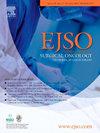Stair climbing outperforms gait speed in predicting postoperative outcomes in patients undergoing radical gastrectomy for gastric cancer: A prospective study
IF 3.5
2区 医学
Q2 ONCOLOGY
引用次数: 0
Abstract
Background
Stair climbing test (SCT) and gait speed test (GST) are two physical performance measures, both of which are associated with postoperative outcomes. However, few studies have compared these two tests for the prognostic value.
Methods
A prospective study was conducted in patients undergoing radical gastrectomy for gastric cancer. Handgrip strength (HGS) test, 7-steps SCT and 6-m GST were performed before surgery. Body compositions were analyzed using abdominal computed tomography (CT). Sarcopenia was diagnosed by low HGS plus either low muscle mass or quality.
Results
A total of 548 patients were included in this study. Time of GST and SCT were both significantly correlated with HGS, skeletal muscle index and skeletal muscle density, but not with subcutaneous or visceral fat area. Low SCT performance (SCT time ≥12.65s) was associated with higher incidence of postoperative complications and longer postoperative length of stay, whereas low GST performance (GST time ≥5.45s) did not. Low performance in SCT and GST were both associated with worse overall survival (OS) and disease-free survival (DFS) after surgery. Low SCT performance was an independent predictor for postoperative complications, OS, and DFS, whereas low GST performance was not significant in multivariate analyses adjusting for the same covariates. The combination of sarcopenia with low SCT performance showed higher accuracy in predicting postoperative complications and mortality compared with sarcopenia combined with low GST performance.
Conclusion
SCT outperformed GST in predicting outcomes after radical gastrectomy for gastric cancer, either as a singular indicator or in combination with sarcopenia assessments.
爬楼梯在预测胃癌根治术患者术后效果方面优于步速:一项前瞻性研究。
背景:爬楼梯测试(SCT)和步态速度测试(GST)是两种体能测试方法,均与术后预后相关。然而,很少有研究对这两种测试的预后价值进行比较:方法:对接受胃癌根治术的患者进行了一项前瞻性研究。方法:对接受胃癌根治术的患者进行了一项前瞻性研究。术前进行了手握力(HGS)测试、7 步 SCT 和 6 米 GST。腹部计算机断层扫描(CT)分析了患者的身体成分。根据低 HGS 加低肌肉质量或肌肉质量来诊断 "肌肉疏松症":本研究共纳入了 548 名患者。GST 和 SCT 的时间均与 HGS、骨骼肌指数和骨骼肌密度显著相关,但与皮下或内脏脂肪面积无关。低 SCT 性能(SCT 时间≥12.65 秒)与术后并发症发生率较高和术后住院时间较长有关,而低 GST 性能(GST 时间≥5.45 秒)则与之无关。SCT和GST的低水平均与术后较差的总生存期(OS)和无病生存期(DFS)有关。SCT 低水平是术后并发症、OS 和 DFS 的独立预测因素,而 GST 低水平在调整相同协变量的多变量分析中并不显著。在预测术后并发症和死亡率方面,肌肉疏松症合并低SCT表现与肌肉疏松症合并低GST表现相比具有更高的准确性:结论:在预测胃癌根治术后的预后方面,无论是作为单一指标还是与肌肉疏松症评估相结合,SCT都优于GST。
本文章由计算机程序翻译,如有差异,请以英文原文为准。
求助全文
约1分钟内获得全文
求助全文
来源期刊

Ejso
医学-外科
CiteScore
6.40
自引率
2.60%
发文量
1148
审稿时长
41 days
期刊介绍:
JSO - European Journal of Surgical Oncology ("the Journal of Cancer Surgery") is the Official Journal of the European Society of Surgical Oncology and BASO ~ the Association for Cancer Surgery.
The EJSO aims to advance surgical oncology research and practice through the publication of original research articles, review articles, editorials, debates and correspondence.
 求助内容:
求助内容: 应助结果提醒方式:
应助结果提醒方式:


